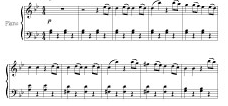
Traditional sheet music is incontrovertibly an essential tool in the human music history.
I am wondering if there is a way to convert a sequence of CVs to sheet music?
(I mean ‘automatically’. Without hiring a musician of course… ![]() )
)

Traditional sheet music is incontrovertibly an essential tool in the human music history.
I am wondering if there is a way to convert a sequence of CVs to sheet music?
(I mean ‘automatically’. Without hiring a musician of course… ![]() )
)
I keep thinking about creating a scoring module since my Meander module already has the basics of sheet music scoring. Also, Meander has time signature and scale (key) signature information. Even so, whereas I could probably make Meander do a score of Meander notes, it is a lot more complicated to do so between modules. I still may try that one of these days.
Over the years I have used various MIDI scoring programs. In recent times I have used MuseScore.
I have most recently considered efforts by @StochasticTelegraph (TTY) and @baconpaul (TIPSY) for inter-module note and other musical song information communications.
But, I would love to see what someone else does with this idea as I am not sure I will do it. It is a musical can of worms!
Perhaps one way is to capture that sequence of CVs into a timeline sequencer like SquinkyLabs Seq++, and then export the sequence to a midi file. The midi file can then be opened in Muse Score, Sibelius or whatever scoring software you use.
Seq++ has very limited recording ability, so probably not.
My immediate thought was poly cv + gate + clock in and lilypond voices out. The hard parts will be the implicit quantization and also what to do if the intent isn’t 12 tet underlying cv but you can probably address those by having a minimum time quantization and just ignoring microtonal notation at first
Can lilypond respond in real-time, note per note as it arrives display it? When I was playing around with TIPSY a while back, I installed lilypad and felt that it could not handle note by note scoring as it occurred, but I could be wrong.
No. Lilypond is LaTeX for music
yeah, the quantization is fiendishly difficult to do well. But, again as you say, it’s probably not needed for this application. Also, of course, you can’t decently quantize anything until you have the whole measure, so a good version is inherently non-real-time.
I wrote a pretty decent one like 20 years ago. It did a search over quite a large search space. Usually it would finish in a reasonable amount of time, but not always.